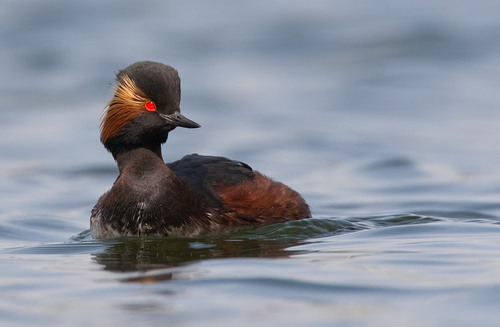
Black-necked Grebe
The Black-necked Grebe (*Podiceps nigricollis*) is a small, elegant waterbird known for its striking breeding plumage and elaborate courtship displays. It plays a vital role in freshwater and saline lake ecosystems, primarily as a consumer of invertebrates and small fish. This species exhibits significant seasonal changes in appearance and behavior, making it a fascinating subject for birdwatchers and ecologists. While not globally threatened, certain populations face localized challenges due to habitat loss and environmental changes. The Black-necked Grebe has no particular cultural significance.
28-34 cm
Length
52-59 cm
Wingspan
Least Concern
Conservation Status
Distribution
The Black-necked Grebe has a wide distribution, found across North America, Europe, Asia, and Africa. It breeds in temperate regions and migrates to warmer areas for the winter. Altitudinal range varies from sea level to high-elevation lakes.
Lifespan
The average lifespan in the wild is not well-documented, but likely ranges from 5-10 years. Captive individuals may live longer.
Black-necked Grebe's Habitat
Habitat Types
Freshwater lakes, Saline lakes, Marshes, Reservoirs, Coastal lagoons (during winter)
Climate Zones
Temperate, Subarctic, Mediterranean, Steppe
Adaptations
Black-necked Grebes have lobed toes, which provide excellent propulsion underwater. They also have dense, waterproof plumage for insulation in cold water. Their legs are set far back on their bodies, an adaptation to swimming, but making them clumsy on land.
Variations
Three subspecies are generally recognized: *P. n. nigricollis* (Europe and Asia), *P. n. gurneyi* (Southern Africa), and *P. n. californicus* (North America). These subspecies show slight variations in size and plumage.
Appearance
Breeding Plumage
Breeding plumage features a black head and neck, golden ear tufts, and a reddish-brown body. Non-breeding plumage is much duller, with a grayish-black back and head, and a white neck and underparts.
Seasonal Feather Changes
Plumage changes dramatically between breeding and non-breeding seasons, with the most striking difference being the head and neck coloration.
Sex Based Plumage Differences
Minimal; males may have slightly brighter breeding plumage, but differences are subtle.
Notable Features
Lobed toes (not webbed), Golden ear tufts (in breeding plumage), Sharp, pointed bill, Red eyes
Diet and Feeding
Primary Foods
Aquatic insects, Crustaceans, Small fish, Mollusks, Amphibian larvae
Foraging Behavior
Black-necked Grebes primarily forage by diving underwater and pursuing prey. They can stay submerged for up to a minute. They also glean insects from the water surface.
Specializations
Their lobed toes are highly efficient for underwater propulsion. The grebe's bill is adapted for catching and holding slippery prey.
Seasonal Diet Variations
Diet may shift depending on prey availability. During the breeding season, insects often make up a larger proportion of the diet, while fish and crustaceans may be more important in winter.
Behavior
Social Structure
Black-necked Grebes are often found in loose colonies during the breeding season, sometimes numbering hundreds or even thousands of pairs. Outside of breeding, they may form smaller flocks or be solitary.
Communication
Whinnying calls, Trilling calls, Clicking sounds (during courtship), Visual displays (head shaking, bill dipping)
Migration
Many populations are migratory, moving from breeding areas to ice-free waters for the winter. Migration routes and distances vary depending on the population.
Territorial or Group Behaviors
During breeding, pairs defend small territories around their nests. Outside of the breeding season, they are generally less territorial.
Conservation
Threats
Habitat loss and degradation (wetland drainage), Pollution (pesticides, heavy metals), Climate change (altered precipitation patterns, increased salinity in some lakes), Disturbance from human activities (recreational boating), Oil spills
Protection Programs
Wetland conservation and restoration efforts, International agreements (Ramsar Convention on Wetlands), Monitoring of breeding populations
Local National Laws
Protected under various national and international wildlife laws, such as the Migratory Bird Treaty Act in the United States and Canada.
Population Trend
Stable
Population Estimates
The global population is estimated to be between 3.9 - 4.2 million individuals.
Interesting Facts
They eat their own feathers.
This behavior is thought to help protect the stomach lining from sharp fish bones and to aid in the formation of pellets of indigestible material that are regurgitated.
Chicks are precocial.
They can swim and dive shortly after hatching, although they still rely on their parents for food and protection.
They can adjust their buoyancy.
By controlling the amount of air trapped in their plumage and air sacs, they can float high on the water or sink low, leaving only their head exposed.
They are clumsy on land.
Due to their legs being positioned far back on their body.
Faqs about Black-necked Grebe
What is the difference between a Black-necked Grebe and an Eared Grebe?
The Eared Grebe (*Podiceps auritus*) is very similar, but in breeding plumage, the Eared Grebe has a more prominent golden ear tuft that extends further back and a flatter head profile. Non-breeding plumages are more difficult to distinguish.
Where can I see Black-necked Grebes?
Look for them on freshwater or saline lakes, marshes, and reservoirs during the breeding season. In winter, they can also be found in coastal areas.
Are Black-necked Grebes endangered?
No, they are currently classified as Least Concern by the IUCN. However, some local populations may be threatened by habitat loss or other factors.
Do they mate for life?
Black-necked grebes are thought to form new pair bonds each breeding season, so they do not mate for life.
Copyright @ Nature Style Limited. All Rights Reserved.
 English
English